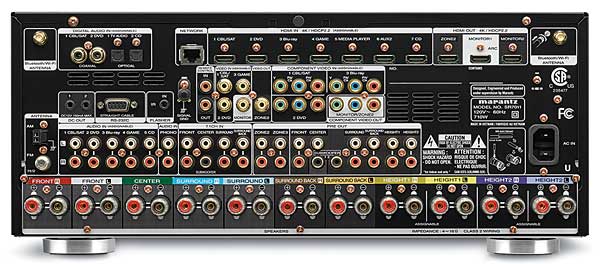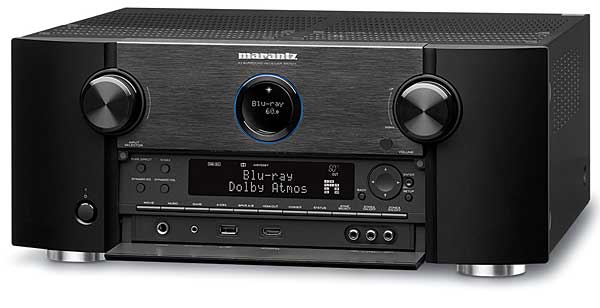Thank you for your detailed review! I own a pair Sonus Faber Grand Piano Domus(FR&FL), Center Domus(center) and a pair of Concertino Domus(SR&SL). I was wondering your thoughts on the best receiver to power them. A sales guy told me that the Marantz SR7011 should be plenty to power my set up but I'm not too sure about that. I have been thinking maybe just get the Marantz SR6011 and use the pre-outs with a 3 channel Emotiva XPA gen 3(which is possibly overkill) for the fronts and just power the surrounds with the SR6011. My budget is around $2,500, which is maybe not enough. I've been researching the furums for a couple of days now and haven't been able to figure out the best solution to power my Sonus Faber speakers. Any help you can provide would be greatly appreciated. Thank you!
Marantz SR7011 A/V Receiver Review

AT A GLANCE
Plus
Nine amp channels
HEOS multiroom
compatibility
Audyssey, ISF, Control4, Crestron
Minus
No PC-friendly USB jack
THE VERDICT
The Marantz SR7011 is a state-of-the-art receiver with excellent room correction, fine overall sound, and the potential for HEOS multiroom extension.
The D+M Group was formed in 2002 with the merger of Denon and Marantz, each a powerhouse in A/V receivers and other audio categories. Through several changes of ownership, the two brands have remained distinct, with different cosmetic looks, slightly different feature sets, and slightly different voicings; each team has its own sound-tuning engineers and expert listeners. But as a reader once pointed out, popping the lid on comparably priced models from the two brands may reveal a close kinship in circuit layouts, suggesting certain economies of scale. And the new top-of-the-line AVR from Marantz further mimics its sister brand by adopting HEOS multiroom connectivity, a feature previously associated with Denon. Our review sample of the receiver arrived with Denon’s HEOS 7 and HEOS 1 speakers, and we put them through their paces together.
New Flagship Sets Sail
The SR7011 ($2,199) is the uppermost of four new Marantz receivers as well as the new flagship. However, it isn’t the only model with the nine amp channels needed to run Dolby Atmos and DTS:X in their 5.1.4-channel configurations. The SR6011 ($1,399) also has nine amp channels, with less power, for $800 less, while the SR5011 ($899) and slimline NR1607 ($699) have seven amp channels. Continuing in the line are the nine-channel SR7010, seven-channel NR1606, and five-channel NR1506. While the decoder outputs only one LFE channel, all have two subwoofer outputs. The dual outs may be adjusted individually, either manually or by the Audyssey processing.
The 9.1-channel receivers share the cosmetic look that Marantz reserves for their top models, with a curved front panel graced by a small blue-ringed porthole display in the center—and seemingly nothing else, apart from two big knobs and a power button. That wouldn’t appear to leave much room for functionality, but beneath the porthole, there’s a flip-down door that reveals a larger (and more readable) display. That’s also where you’ll find certain controls that work the graphic user interface and select listening modes, with dedicated buttons for the Audyssey Dynamic EQ and Dynamic Volume modes—as well as the Direct and Pure Direct modes, which strip out room correction and other processing, and the M-DAX mode, which attempts to gussy up MP3 and other compressed audio formats.
 >{?
HEOS is far from the only significant audio feature in this high-striving receiver. It borrows HDAM (Hyper Dynamic Amplifier Module) topology from the two-channel components in Marantz’s Reference series. Also on board are Audyssey MultEQ XT32, that company’s top-of-the-line room-correction scheme, with the highest filter resolution, and Audyssey Sub EQ HT, which allows each subwoofer to be separately room-corrected. Meanwhile, the aforementioned Audyssey Dynamic EQ and Dynamic Volume can be used separately or together to fine-tune low-volume listening.
>{?
HEOS is far from the only significant audio feature in this high-striving receiver. It borrows HDAM (Hyper Dynamic Amplifier Module) topology from the two-channel components in Marantz’s Reference series. Also on board are Audyssey MultEQ XT32, that company’s top-of-the-line room-correction scheme, with the highest filter resolution, and Audyssey Sub EQ HT, which allows each subwoofer to be separately room-corrected. Meanwhile, the aforementioned Audyssey Dynamic EQ and Dynamic Volume can be used separately or together to fine-tune low-volume listening.
We expect most receivers from the middle of the line and up to have triple wireless connectivity, and the Marantz doesn’t disappoint, with Wi-Fi, AirPlay, and Bluetooth. We expect pretty much all but the cheapest or oldest currently sold receivers to have decoding for both Dolby Atmos and DTS:X height-enhanced object-oriented surround sound, and the Marantz throws in Auro-3D, for which an alternative height-layer speaker layout is recommended. While the optimized arrangement for a 9.1-channel Auro setup is somewhat different than what’s common in the more widely used Dolby and DTS immersive formats, compatibility settings are included. You’ll need an outboard amp to fulfill the receiver’s full 10.1-channel Auro-3D, or 11.1 Atmos/DTS:X potential. As with prior Marantz and Denon AVRs, Auro-3D requires a $199 firmware update
Music services available through the HEOS app include Pandora, Amazon Prime Music, Deezer, Napster, SoundCloud, Tidal, Mood: Mix, iHeart Radio, SiriusXM, and TuneIn internet radio. TuneIn, which aggregates more than 100,000 internet radio stations and 4 million podcasts, is also available directly through the AVR GUI. An HD Radio tuner accesses digital channels over the FM airwaves. High-resolution-audio addicts can access lossless ALAC, FLAC, and WAV files up to 192 kilohertz and 24 bits as well as DSD at both 2.8 and 5.6 megahertz via the front USB port and DLNA (network) sources. Unfortunately, the USB input doesn’t allow direct computer connection. I’ve not seen one in recent memory that does, but I think this should be standard equipment in upper-tier AVRs.
On the video side, the SR7011 welcomes your new Ultra HD Blu-ray player and other UHD sources with HDMI 2.0b and HDCP 2.2 DRM to ace the copyright handshake. UHD without HDR improvements is like a day without sunshine, so HDR10 signals are accommodated, and Dolby Vision will follow in a future firmware update. The receiver handles UHD video at 60 hertz with 4:4:4 color subsampling and BT.2020 passthrough on every input. In other words, it supports UHD at a high frame rate, with no compression of the color signal, and the widest color gamut supported by current massmarket technology—along with 3D and widescreen 21:9 video. Furthermore, the receiver is certified by ISF, the Imaging Science Foundation, enabling a custom installer to perform advanced video calibrations and fine-tune what the receiver is feeding your display. You might ask him to exploit the built-in Control4 and Crestron home automation compatibilities as well.
Your flagship-receiver bucks buy a few extra connectivity niceties. One now rare feature is a set of 7.1-channel analog inputs to bypass the HDMI audio connection—either because you have a classic multi-channel source component or because you want to use the exotic DAC in a newer one. A phono input is also provided. Speaker terminals and pre-outs both cover 11.1 plus extra sub connectivity for Auro-3D or switching between 5.1.4 and 7.1.2 configurations (rearheight versus back-surround channels) without a cable swap.

Associated equipment included five Paradigm Reference Studio 20 v.4 speakers, four Klipsch RP-140SA elevation module speakers, and a Paradigm Seismic 110 subwoofer, along with an Oppo BDP-83 universal disc player, Micro Seiki BL-51 turntable, Shure M97xE cartridge, and Denon PRA-S10 stereo preamp serving as phono preamp. All movie demos were on Blu-ray with Dolby Atmos soundtracks, which I ran in a 5.1.4 configuration.
Dynamic, Clean, Open
The SR7011 combines the dynamics you’d expect in a receiver for just over two grand with the clean and open midrange you’d expect in a Marantz. There are even more expensive receivers that provide more power—and outboard multichannel power amps that provide a lot more. But the Marantz is a fine match for any speakers whose sensitivity is just slightly on the low side of today’s average, like my Paradigms, or higher. The bubble-shaped soundfield of Dolby Atmos was well illuminated but without hardening textures. The top end was sweet and musical, dialogue well delivered, and bass par for the price point. This is a reasonable definition of a great-sounding receiver.
Game of Thrones, season 6, broke in the receiver and provided some of its most dynamically memorable moments. Cersei’s destruction of the Great Sept of Baelor by the combustible green fluid called Wildfire benefited not only from a good match of receiver and speakers but also from Audyssey MultEQ XT32’s fine-tuning of my single sub’s output. The brutal battle between the armies of the North generated a soundfield that was action-packed with grunts and thunks. Even without gunpowder, this mock-medieval battle was so mesmerizing as to be exhausting. It certainly helped that Audyssey room correction left no weak spots in the soundfield formed by my identical (but asymmetrically positioned) speakers.
I continued with the combustible-fluid theme by cueing up Deepwater Horizon, which tells the true (dramatized) story of the oil rig that blew up in the Gulf of Mexico, causing death, destruction, and the largest oil spill in U.S. history. The roar of combustion assaulted the ceiling (through the Klipsch elevation module ceiling-firing speakers) and filled the room. Dialogue clarity amid the high-decibel chaos was exemplary; the receiver managed to power nine busy speakers and hold everything together.
- Log in or register to post comments


I like outlaw audio amps more than emotiva, but both are good value amps. I live in Utah but have bought a lot of marantz gear from safeandsoundhq.com, call those guys up, they will for sure take care of you and help you figure out what to do under your budget. I bet you'd be able to squeeze in both the av7703 and a good amp.

I like outlaw audio amps more than emotiva, but both are good value amps. I live in Utah but have bought a lot of marantz gear from safeandsoundhq.com, call those guys up, they will for sure take care of you and help you figure out what to do under your budget. I bet you'd be able to squeeze in both the av7703 and a good amp.

If anyone is still reading these old reviews, can you tell me what HDAM is? I couldn't find a good explanation on the Marantz website. Also does this receiver have the same sensitivity issues with the line-outs like the Denon receivers? I use a Lexicon LX-5 amp with the 7011 to run the front, center and surround speakers. Everything sounds fine but I'd like to know what kind of signal the amp is receiving.





































































